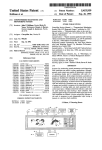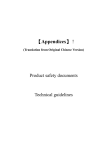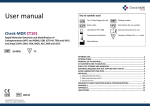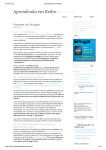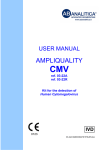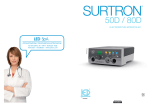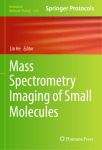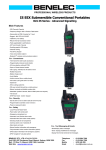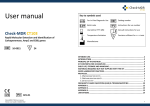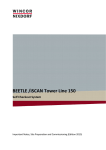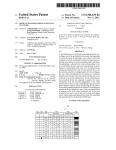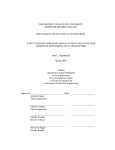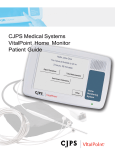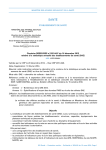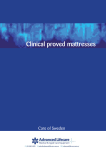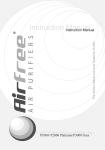Download USER MANUAL
Transcript
USER MANUAL MB REF. 03-17A Kit for the identification of DNA of Mycobacterium tuberculosis 1. KIT CONTENT 3 2. STORAGE AND STABILITY OF REAGENTS 4 3. PRECAUTIONS FOR USE 4 4. SAFETY RULES 5 4.1. General safety rules 5 4.2. Safety rules about the kit 6 5.1 Reagents 7 5.2 Instruments 7 5.3 Materials 7 7. INTRODUCTION 9 8. TEST PRINCIPLE 10 10. COLLECTION, MANIPULATION AND PRE- TREATMENT OF SAMPLE 11 10.1 Respiratory specimens 12 10.2 Histological samples 12 10.3. Blood 13 10.4. Liquor 14 11 AMPLIFICATION PROTOCOL 14 11.1 DNA EXTRACTION 14 11.2 DNA AMPLIFICATION 11.2.1 ß-Globin DNA amplification 11.2.2 M. tuberculosis DNA amplification 15 15 15 11.3 VISUALIZATION OF AMPLIFIED PRODUCTS 17 11.3.1 Agarose gel electrophoresis 17 11.3.2 Sample loading 17 11.3.3 Interpretation of the results: DNA amplification of ß-Globin and M. tuberculosis 19 12 TROUBLESHOOTING 21 13 DEVICE LIMITS 23 pag. 1 03-17R-25(8033622780120)-EN.doc 14 DEVICE PERFORMANCES 23 14.1 Specificity 23 14.2 Diagnostic significance 23 14.3 Diagnostic and analytic sensitivity 23 15 BIBLIOGRAPHIC REFERENCES 24 INFORMATION FOR ORDERS 25 15.2 25 Related products pag. 2 03-17R-25(8033622780120)-EN.doc 1. KIT CONTENT BOX P DESCRIPTION STORE AT – 20°C COLOUR OF TUBE (T) OR LID LABEL Monodose premix tube MB 50 test 8 test 25 50 8 Blue (T) 25 50 8 Red 1 x 37,5 μL 1xX 75 μL 1 x 12 μL Colourless(T) Monodose premix tube BG Taq DNA polymerase termostable 25 test AB TAQ 5 U/μL SMALL BAG Plasmidic DNA containing a part of mycobacteria genome STORE AT – 20°C Positive control MB Blue BOX F 1 x 60 μL 1 x 100 μL 1 x 20 μL STORE AT +2°-+8°C Electrophoresis Buffer for sample loading Blu 6X Blue 1 x 150 μL 1 x 300 μL 1 x 50 μL Ethidium Bromide solution (2,5 mg/mL) Ethidium Bromide Red 1 x 150 μL 1 x 250 μL 1 x 100 μL Yellow 1 x 150 μL 1 x 260 μL 1 x 50 μL DNA molecular weight marker TOSSICO R 23 68 S 36/37 45 MW Marker STORE AT +15°-+25°C BOX A Agarose for molecular biology AGAROSE 1 x 15 g 1 x 27 g 1x5g Electrophoresis Buffer TRIS-Acetate-EDTA pH: 8,00 TAE 50X 1 x 50 mL 1 x 100 mL 1 x 20 mL pag. 3 03-17R-25(8033622780120)-EN.doc 2. STORAGE AND STABILITY OF REAGENTS Each component of the kit should be stored according to the directions indicated on the label of the single boxes. In particular: Box P Small bag Box F Box A store at -20°C store at -20°C store at a +2/+8°C store at +15/+25°C When stored at the recommended temperature, all test reagents are stable until their expiration date. 3. PRECAUTIONS FOR USE • The kit should be handled by investigator qualified through education and training in molecular biology techniques applied to diagnostics; • Before starting the kit procedure, read carefully and completely the instruction manual; • Keep the product out of heating sources; • Do not use any part of the kit if over the expiration date; • In case of any doubt about the storage conditions, box integrity or method application, contact AB ANALITICA technical support at: [email protected] . In the amplification of nucleic acids, the investigator has to take the following special precautions: • Use filter-tips; • Store the biological samples, the extracted DNA, positive control included in the kit and all the amplification products in different places from where amplification reagents are stored. • Organise the space in different pre- and post-PCR units; do not share pag. 4 03-17R-25(8033622780120)-EN.doc consumables (pipets, tips, tubes, etc) between them. • Change the gloves frequently; • Wash the bench surfaces with 5% sodium hypochloride; • Thaw the PCR premixes at room temperature before use. Add the Taq DNA polymerase and purified DNA very quickly at room temperature or in an ice-bath. 4. SAFETY RULES 4.1. General safety rules • Wear disposable gloves to handle the reagents and the clinical samples and wash the hands at the end of work. • Do not pipet with mouth. • Since no known diagnostic method can assure the absence of infective agents, it is a good rule to consider every clinical sample as potentially infectious and handle it as such. • All the devices that get directly in touch with clinical samples should be considered as contaminated and disposed as such. In case of accidental spilling of the samples, clean up with 10% Sodium Hypochloride. The materials used to clean up should be disposed in special containers for contaminated products. • Clinical samples, materials and contaminated products should be disposed after decontamination by: immersion in a solution of 5% Sodium Hypochloride (1 volume of 5% Sodium Hypochloride solution every 10 volumes of contaminated fluid) for 30 minutes OR autoclaving at 121°C at least for 2 hours (NOTE: do not autoclave solutions containing Sodium Hypochloride!!). pag. 5 03-17R-25(8033622780120)-EN.doc 4.2. Safety rules about the kit The risks for the use of this kit are related to the single components: Dangerous components: 3,8-diamino-1-ethyl-6-phenylphenantridiumbromide (Ethidium Bromide) <2% Description of risk: T (Toxic) RISK SENTENCES AND S SENTENCES ETHIDIUM BROMIDE R 23 and R 68 S 36/37 45 Toxic for inhalation. Risk of irreversible effects. Wear laboratory coat and disposable gloves. In case of accident or discomfort, seek for medical assistance and show the container of label. R and S sentences refer to the concentrated product, as provided in the kit. In particular, for Ethidium Bromide, until the dilution in the agarose gel. In manipulating concentrated Ethidium Bromide, use a chemical dispensing fume cabinet. Always wear disposable gloves and laboratory coat in manipulating the diluted Ethidium solution as well. The product can not be disposed with the common waste. It must not reach the drainer system. For the disposal, follow the local law. In case of accidental spilling of Ethidium Bromide, clean with Sodium hypochloride and water. Safety data sheet (MSDS) of Ethidium Bromide is available upon request. pag. 6 03-17R-25(8033622780120)-EN.doc 5. MATERIALS REQUIRED, BUT NOT PROVIDED 5.1 Reagents • Sterile DNase and RNase free water; • Distilled water. 5.2 Instruments • Laminar flow cabinet (use is recommended while adding TAQ polymerase to the amplification premix to avoid contamination; it would be recommended to use another laminar flow cabinet to add the extracted DNA); • Micropipettes (range: 0,2-2 µL; 0,5-10 µL; 2-20 µL); • Thermalcycler; • Microcentrifuge (max 12.000-14.000 rpm); • Balance; • Magnetic heating stirrer or microwave; • Chemical cabinet (use is recommended in handling Ethidium Bromide); • Horizontal electrophoresis chamber for agarose minigel; • Power supply (50-150 V); • UV Transilluminator; • Photo camera or image analyzer. 5.3 Materials • • • • • Disposable gloves; Disposable sterile filter-tips (range: 0,2-2 µL; 0,5-10 µL; 2-20 µL;); Graduate cilinders (1 L) for of TAE dilution; Pyrex bottle or Becker for agarose gel preparation; Parafilm. pag. 7 03-17R-25(8033622780120)-EN.doc 6. PREPARATION OF REAGENTS Preparation of 1 L of 1X TAE buffer: Mix 20 mL of 50X TAE with 980 mL of distilled water. pag. 8 03-17R-25(8033622780120)-EN.doc 7. INTRODUCTION Mycobacteria are gram-positive bacilli, alchool-acid resistant, asporigenic, strictly aerobics or microaerophilic, motionless. The Mycobacterium genre encompasses the Mycobacterium tuberculosis complex and more than 80 species of non tubercular mycobacteria (atypical) which include pathogen species, opportunistic and non pathogen species. The most important species of Mycobacterium genre is M. tuberculosis, the aetiological agent of tuberculosis, one of the most important infectious diseases in the world, which counts 8 millions of new cases and more than 2 millions of deaths every year (Dye et al., 1999). The most diffused and known form of tuberculosis is the pulmonary disease, even if almost each organ could be involved. M. tuberculosis is an intracellular pathogen that, during the infection, involves macrophages and monocytes of peripheral blood, macrophages of peripheral tissues, promonocytes and monocytes of bone marrow. In immunocompetent subjects the mycobacterium-macrophage interaction leads to the activation of the same macrophage with a consequent bacterial lysis caused by processes of enzymatic digestion and oxidation. To the contrary, in immunocompromised subjects the inability to activate a bactericidal action is considered the main cause of Mycobacterium systemic diffusion. As regards the pathogenicity mechanisms and the virulency factors, the molecular data report the involvement of the elements that characterize the structure of the bacterial wall of the micro-organism (lipoarabinomannan, sulfatide and proteins) in particular for the activation of cell-mediated immunitary response. The sulfatide seems to be the first responsible for macrophage activation and for the increased secretion of IL-1β and TNF-α, favouring the formation of granulomas that slowly develop giving a very extended tissutal destruction. The observed hystopathological lesions could be exudative lesions, characterized by acute inflammation, exudate formation and accumulation of PMN leucocytes around the bacilli, and productive lesions (granulomatous) characterized by concentric distribution of macrophages (epithelioid cells) to form tubercles and giant cells. Even though the initial diagnosis of Mycobacteria infection is often based on clinical data, the definitive diagnosis requires isolation and identification of the micro-organism in a laboratory. The classic laboratory procedures for clinical samples analysis involve the decontamination and digestion of the specimen, the direct microscopic detection of the presence of AFB (acid – fast bacilli) after staining of the slides prepared with infectious materials, with Ziehl-Neelsen, the staining with rhodamine-auramine fluorescent mix, the isolation of the micro-organism in pag. 9 03-17R-25(8033622780120)-EN.doc culture and test of drug resistance. Due to the reduced growing speed of Mycobacteria, their isolation requires some weeks (at least 3-9 weeks with optimum temperature at 37°C) In the last ten years different molecular methods for direct identification of Mycobacteria have been developed. The identification of Mycobacterium tuberculosis with classical methods based on the phenotype, on the biochemical characteristics and on the use of chromatographic techniques requires long execution time, not suitable for routine screening. PCR-based methods allow to get the same information with less time and costs. (Stauffer et al., 1998; Glennon et al., 1994). 8. TEST PRINCIPLE PCR method (Polymerase Chain Reaction) has been the first method of DNA amplification described in literature (Saiki RK et al., 1985). It can be defined as an in vitro amplification reaction of a specific part of DNA (target sequence) by a thermostable DNA polymerase. Three nucleic acid segments are involved in the reaction: double stranded DNA template to be amplified (target DNA) and two single-stranded oligonucleotides “primers” that are designed in order to anneal specifically to the template DNA. The DNA polymerase begins the synthesis process at the region marked by the primers and synthesizes new double stranded DNA molecules, identical to the original double stranded target DNA region, by facilitating the binding and joining of the complementary nucleotides that are free in solution (dNTPs). After several cycles, one can get millions of DNA molecules which correspond to the target sequence. The sensitivity of this test makes it particularly suitable for the application in laboratory diagnostics. Moreover, the amplification reaction can be executed from a wide range of biological samples and since it allows to amplify very small DNA fragments, the starting DNA can be also partially degraded. pag. 10 03-17R-25(8033622780120)-EN.doc 9. PRODUCT DESCRIPTION The method of the MB kit consists of the amplification of a highly conserved and repeated region of the Mycobacterium tuberculosis genome, the insertion sequence IS986 (IS6110). This sequence is generally present in 1 to 20 copies for each bacteria. The method also allows to evaluate the suitability of extracted DNA for the amplification, by amplification of the β-globin gene (amplification control). A negative result in β-globin gene amplification indicates either the presence of inhibitors of the amplification reaction in the extracted DNA or that the DNA is highly degraded. This method helps the operator to recognize possible false negative results. The kit also provides with positive controls of amplification. When the amplification of the positive control is successful, it is guaranteed that the reaction is correct. These controls are not dangerous for the operator because they are plasmid DNA containing only a part of Mycobacterium tuberculosis genome. MB kit is in premix format: all the reagents for the amplification are pre-mixed and aliquoted in monodose test tubes (0,2 or 0,5 mL) to which Taq polymerase and the extracted DNA will be added. This premix format allows the reduction of the manipulation steps in preamplification, with considerable time saving for the operator; the repeated freezing/thawing of reagents (that could alter the product performances) is avoided and, above all, this form minimizes the risk of contamination, so the risk to get false positive results. Nevertheless, it’s always recommended to use all the proper amplification controls. 10. COLLECTION, MANIPULATION AND PRETREATMENT OF SAMPLE The samples used for the determination of Mycobacterium tuberculosis infection by microbiological analysis and molecular biology, are respiratory specimens (saliva, sputum, expectorates, bronchial secretions obtained by bronchoscopy, bronchoalveolar washings) and other kinds (pleuric essudates, pulmonary, lymphonodal and cutaneous and pleuric biopsies, peripherial blood, gastric aspirates that contain swallowed excretions, liquor and bone marrow), as well as cultures (Riggio et al., 1997; Gulletta, 1995). pag. 11 03-17R-25(8033622780120)-EN.doc Generally, given that tuberculosis is a disease with aerogenic infection, the infection risk is correlated to the possibility of transmission of the microorganism present in air. Some of the laboratory activities (such as centrifugation, stirring) are more risky, therefore those operations must be performed with great caution. It is very important to use vertical laminar flow cabinet during manipulation of Mycobacterium tuberculosis; use disposable loops for collection of cultured strains and autoclave the waste materials. 10.1 Respiratory specimens For safety during collection of the biological specimen, it is a good rule to consider every clinical sample as potentially infectious and handle it as such. Expectorate collection and bronchoscopy, that could cause diffusion of infected mycobacteria in the environment, should be done in suitable rooms and the staff should use an appropriate protection barrier. The respiratory samples (excreta) could be fluidified by N-acetil-L-cysteine (1,5%) or dithiothreitol (0,1%), the fluidifier should be added in equal volume with the excretum (directly on the collection box) and left at 37°C for 15-30 min according to the material consistency. Generally, respiratory samples are decontaminated by adding 4% NaOH solution, then, after centrifugation, neutralized with HCl. The obtained pellet could be resuspended in PBS. The collection boxes should be sterile, with screw cap and disposable. To have a significant exam, the sample should not be saliva, but should be a sample from deep respiratory tract. Fresh or decontaminated samples should be stored at + 2 /+ 8°C for short time (not more than 48 hours), or at -20°C for a longer period (up to some months). 10.2 Histological samples Histological samples are pulmonary, skin, lymphonodal and pleural biopsies, fresh, frozen, formalin-fixed and paraffin embedded. Perform the bioptical sample collection as routine. Fresh biopsies can be treated within few minutes from sampling, or quickly frozen with liquid nitrogen and successively stored at -80°C until mechanic disgregation by using a sterile cutter, followed by enzymatic digestion. pag. 12 03-17R-25(8033622780120)-EN.doc In case that the biopsy is fixed and paraffine-embedded, it is suggested the use of formalin buffered at pH 7 with sodium and potassium salts at 10%, as Lilie formula. Tissue fixation with not-buffered formalin in Bouin, Holland or other acidic fixatives (osmic acid, for istance) are not suitable for subsequent DNA extraction because that substances produce cross-links in the tissue, making it not-digestible. In case of fresh or frozen histological samples (up to about 50 mg), it is suggested to proceed immediately with the mechanic disgregation of tissue by using a sterile cutter. Do this operation on a glass slide, adding an aliquote of 1X PBS buffer. Transfer the minced tissue in a tube by a Pasteur pipette, and proceed with sample digestion. If the histological sample is formaline fixed and paraffine-embedded, proceed with paraffin removal and then with the enzymatic digestion. 10.3. Blood The Mycobacterium tuberculosis searching could be done starting from peripheral blood, which could be the best material in case of extrapulmonary or scattered tuberculosis. Sample collection should follow all the usual sterility precautions, and should be transported in sterile boxes, without transport medium. Blood should be treated with EDTA. Other anticoagulating agents, as heparin, are strong inhibitors of TAQ polymerase and so they could alter the efficiency of the amplification reaction. Fresh blood can be stored at +2/+8°C (processed within 4 hours from the collection); if DNA is not shortly extracted, the sample must be frozen at 20°C. A further step for lymphocytes isolation with a Ficoll-Hypaque system or an erythrocyte lysis protocol is suggested. pag. 13 03-17R-25(8033622780120)-EN.doc 10.4. Liquor Also for this clinical specimen, sample collection should follow all the usual sterility precautions and should be transported in sterile boxes, with transport buffer (1X PBS) addded. In this case decontamination is not necessary. Collect the biggest possible volume. Fresh liquor can be processed immediately after the collection, otherwise it can be stored at +2 / +8°C (if processed within 4 hours from the collection). Freezing the sample is not suggested. 11 AMPLIFICATION PROTOCOL 11.1 DNA EXTRACTION For DNA extraction from respiratory specimens, microbial culture in solid or liquid medium and histological samples, AB ANALITICA suggests to use CLEAN MYC kit (AB ANALITICA, cod. 04-40), with which the kit has been standardized. This method involves the use of Proteinase K and Lisozyme (bacteriolityc enzymatic protein able to break the glicosidic β (1-4) bonds responsible for wall rigidity). The two solutions allow the demolition of the wall surrounding the mycobacterium that makes difficult the DNA extraction. Other DNA extraction methods can be used. In particular, some good results have been obtained with an extraction system which causes cellular lysis by repeated steps of freezing/boiling. During this steps it could be useful to add Tris-EDTA and Chelex 100 to the sample; these solutions stabilize the DNA during the boiling step, keeping the ionic force of the sample. In literature it is described the combination of a first step of freezing/boiling with bacteria lysis by Lisozyme and Proteinase K digestion (Niyaz et al., 1998). In any case it is necessary to remember that the volumes of the extract, indicated in paragraph 11.2.1 and 11.3.1 for β-globin and Mycobacterium tuberculosis amplification (20 μL), are referred to extracts obtained with AB ANALTICA methods. Using an alternative extraction method, if the volume of the DNA solution to amplify is less than 20 μL, it will be necessary to adjust the volume of the amplification mix by adding water. pag. 14 03-17R-25(8033622780120)-EN.doc 11.2 DNA AMPLIFICATION 11.2.1 ß-Globin DNA amplification Add to each premixed test tube (blue tubes): AB Taq Extracted DNA 0,2 μL 20 μL It is important to include in each experiment a negative control to monitor the contamination (add distilled water to the mix instead of extracted DNA) and a positive control (any genomic DNA). 11.2.2 M. tuberculosis DNA amplification Add to each premixed test tube (colourless tubes): AB Taq Extracted DNA 0,5 μL 20 μL It is important to include in each experiment a negative control to monitor the contamination (add distilled water to the mix instead of extracted DNA) and 20 µL of positive control (included in the kit). pag. 15 03-17R-25(8033622780120)-EN.doc Centrifuge shortly and put the ß-globin test tubes in the thermalcycler programmed as below: 1 cycle 40 cycles 94°C 5 min 94°C 1 min 56°C 1 min 72°C 1 min Amplification fragments length of ß-Globin: 268 bp Centrifugate shortly and put the M. tuberculosis test tubes in the thermalcycler programmed as below: 1 cycle 40 cycles 94°C 5 min 94°C 2 min 68°C 2 min 72°C 2 min Amplification fragments length of M. tuberculosis: 122 bp pag. 16 03-17R-25(8033622780120)-EN.doc 11.3 11.3.1 VISUALIZATION OF AMPLIFIED PRODUCTS Agarose gel electrophoresis Preparation of a 3% agarose gel: Weight 1,5 g of Agarose and pour it into 50 mL of 1X TAE. Leave the solution on a magnetic stirring heater or in a microwave until the solution becomes clear. Allow the gel to cool to “hand warm” and then add 10 µL of Ethidium Bromide solution. NOTICE: Ethidium Bromide is a strong mutagenic agent; always wear gloves and preferably work under a chemical safety cabinet during the handling of this reagent or gels containing it. Place the gel into the appropriate gel casting tray, with the comb placed in and allow the gel to cool at room temperature or in a fridge until the gel becomes solid. When the gel is solidified, remove carefully the comb (pay attention not to damage the gel wells) transfer the tray into the electrophoresis chamber and pour the appropriate amount of TAE buffer so that it covers completely the gel (about 1-2 mm over the gel surface). 11.3.2 Sample loading Mix into a tube or directly on a parafilm layer: 2 μL 10 μL of 6X Blue of PCR product or DNA molecular weight marker (MW Marker) Load the mixture on the gel wells; switch on the power supply and set the voltage between 80-100 V. Run the gel for about 30-45 min, then place the gel on an UV transilluminator and analyze the results by comparing the size of the amplification products with the reference Molecular Weight Marker. *DNA Molecular Weight Marker (Marker MW): 501-489, 404, 353, 242, 190, 147, 110, 89, 67, 34, 26 bp. NOTE: In a 3% agarose gel the 501-489 bp bands are usually not clearly pag. 17 03-17R-25(8033622780120)-EN.doc resolved and appear as an unique band; the 26 and 34 bp bands are sometimes too small to be visible in a 3% agarose gel (because of their low molecular weight). NOTICE: UV rays are dangerous for skin and, above all, eyes: always wear gloves and safety glass or make use of the protection screen of the UV transilluminator. pag. 18 03-17R-25(8033622780120)-EN.doc 11.3.3 Interpretation of the results: DNA amplification of ß-Globin and M. tuberculosis The included controls should show the following results: CONTROL RESULT INTERPRETATION Positive Control present The PCR amplification is correct Negative Control absent Absence of contaminations Then the interpretation of the bands on agarose gel follows the table below BAND RESULT INTERPRETATION ß-Globin band absent ß –Globin band M. tuberculosis band present absent Sample not suitable for amplification (repeat the DNA extraction) Amplificable sample M. tuberculosis negative ß –Globin band M. tuberculosis band present present Amplificable sample M. tuberculosis positive It is possible that positive samples show aspecific bands; this could depend on the type of starting sample (for example paraffin embedded material), but it will not interfere with the analysis. For any further information contact AB ANALITICA technical support e-mail: [email protected] pag. 19 03-17R-25(8033622780120)-EN.doc Fig. 1. 3% agarose gel electrophoresis 1. 2. 3. Positive sample for M. tuberculosis Positive sample for M. tuberculosis MW DNA Marker pag. 20 03-17R-25(8033622780120)-EN.doc 12 TROUBLESHOOTING 1. Neither amplification products, nor positive control DNA band • TAQ polymerase was not correctly added to the premix -Use pipets and tips with suitable volumes (pipet range 0,2 - 2 μL); -Check visually that TAQ polymerase diffuses in the premix: this is easy because the enzyme is dissolved in glycerol that has a higher density; -alternatively, check visually the drop of TAQ polymerase put on the tube wall, then centrifuge briefly. • The thermalcycler was not correctly programmed -Check the conformity of the thermalcycler program and the temperature profile in the instruction manual; then repeat the amplification with the correct program. • The kit doesn’t work properly -Store the premix, TAQ polymerase and positive control at -20°C; -Avoid repeated freezing/thawing of the premix and the reagents. 2. No amplification bands nor for β-globin neither M. tuberculosis in the tested sample, but a good band for positive controls • Problems during the extraction step -Be sure that the extraction kit is adequate and that you followed correctly all the instructions; -Consult the troubleshooting section of the extraction kit; -Repeat the DNA extraction starting from a new sample. pag. 21 03-17R-25(8033622780120)-EN.doc • The amplification was inhibited – Dilute the starting sample with distilled water and TE; – Repeat the DNA extraction from a smaller amount of clinical sample; – Use an adequate extraction system. 3. Presence of aspecific products or extrabands after the visualization of the amplified products in agarose gel • The thermalcycler makes temperature changes too slowly – Do a thermalcycler revision. • The preparation of the amplification reaction has been executed in a long time at room temperature. – Accelerate the work time at room temperature; – Work on ice. • The extracted has not been purified – Use an extraction system which allows a good sample purification. • The starting sample contained degraded DNA – Repeat the extraction step using another clinical starting sample; – Be sure that the sample had been collected and stored in appropriate way. For any further problem contact AB ANALITICA technical support (e-mail: [email protected]. pag. 22 03-17R-25(8033622780120)-EN.doc 13 DEVICE LIMITS The kit can have reduced performances if: the clinical sample is not suitable for this analysis (using of alternative fixatives instead of neutral formalin buffer, not correct sample storing); the DNA is not amplifiable because of the presence of inhibitors of the amplification reaction or due to an inadequate extraction system. The kit has not been stored at the suggested temperature. 14 DEVICE PERFORMANCES 14.1 Specificity Primer sequence alignment in the most important databanks shows the absence of unspecific alignment, and it has guaranteed the amplification of Mycobacterium tuberculosis. Cross reactions with genomic DNA or other pathogenic microorganism nucleic acid have not been revealed. 14.2 Diagnostic significance The increase of tuberculosis incidence and the development of tubercular strains antibiotic resistant request a fast and precise diagnostic method. Generally, for the diagnosis of tubercular disease also the isolation of only one bacillus results to be clinically significant. 14.3 Diagnostic and analytic sensitivity Some bibliographical references have demonstrated that PCR is a very sensitive system able to find 10 tubercular bacillus in a population of 106 cells. Its diagnostic sensitivity is about 84%. pag. 23 03-17R-25(8033622780120)-EN.doc 15 BIBLIOGRAPHIC REFERENCES Dye C, Scheele S, Dolin P, Pathania V, Raviglione MC. JAMA 282, 677-86, 1999. Wayne LG and Sramek HA. Clin Microbiol Rev 5, 1-25, 1992. Horsburgh CR. N Engl J Med 324, 1332-1338, 1991. Saiki RK, Scharf S, Faloona F, Mullis KB, Horn GT, Erlich HA and Arnheim N, Science 230, 1350-1354, 1985 Pai S, Esen N, Pan X, Musser JM. Arch Pathol Lab Med 121, 859-864, 1997. Riggio MP, Gibson J, Lennon A, Wray D, McDonald DG. Gut 41, 646650,1997. Gulletta E. Microbiol Med, 10 (2), 41-44, 1995. Niyaz A, Mohanty AK, Mukhopadhyay U, Batish VK, Grover S. J Clin Microbiol 36 (10), 3094-3095, 1998. Wang S X e Tay L. Jour of Clin Microb, 1932-1934, June 1999. Folgueira L, Delgado R, Palenque E, Aguado J M, Noriega A R. Jour of Clin Microb, 512-515, Mar 1996. Yam W C, Yuen K Y, Seto W H. Clin Chem Lab Med, 36 (8), 597-599, Aug 1998. Afghani B, Stutman H R. Biochem Mol Med, 57 (1), 14-18, Feb 1996. 15.1 Useful web sites http://www.medicalsystems.it/editor/Caleidoscopio/CalPDF/51 cal.pdf pag. 24 03-17R-25(8033622780120)-EN.doc INFORMATION FOR ORDERS MB: Kit for the identification of DNA of Mycobacterium tuberculosis: (cod. 03-17A) The kit contains the reagents for DNA amplification and visualization by agarose gel electrophoresis, the internal control of sample amplificability and positive control. Target region: insertion sequence IS6110 (IS986). Cod. Product # Pkg 03-17A-25 MB – Mycobacterium tuberculosis 25 tests 03-17A-50 MB– Mycobacterium tuberculosis 50 tests MB: Kit for the identification of DNA of Mycobacterium tuberculosis: (cod. 03-17R) The kit contains the reagents for DNA amplification, the internal control of sample amplificability and positive control. Target region: insertion sequence IS6110 (IS986). Cod. Product # Pkg 03-17R-25 MB – Mycobacterium tuberculosis 25 tests 03-17R-50 MB– Mycobacterium tuberculosis 50 tests 15.2 Related products CLEAN MYC: Kit for quick Mycobacteria DNA extraction and purification with a spin-column method, without use of phenol or chloroform, from fresh, frozen and formalinfixed and paraffin-embedded histological specimens, respiratory specimens and microbial cellular cultures in solid or liquid soil. Cod Product # Pkg 05-40-50 CLEAN MYC 50 tests 05-40-100 CLEAN MYC 100 tests pag. 25 03-17R-25(8033622780120)-EN.doc AB ANALITICA srl - Via Svizzera 16 - 35127 PADOVA, (ITALY) Tel +39 049 761698 - Fax +39 049 8709510 e-mail: [email protected]




























